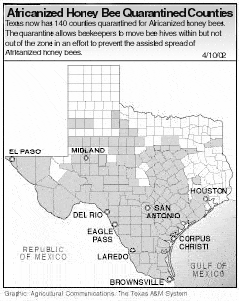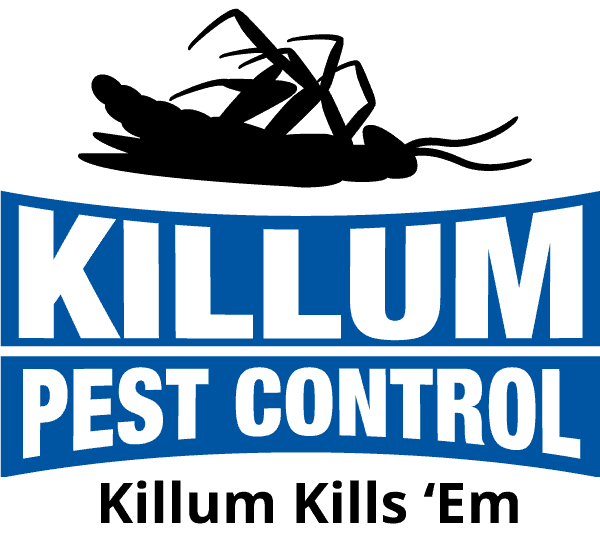General Bee Information
 The first confirmed hive in Brazoria County was found in Angleton in 2001. Over time, the Africanized bees intermingle with the European bees creating hybridized hives. It is impossible for the average person to tell the difference between the Africanized honeybee and the common European honeybee. It takes an expert with sophisticated lab equipment to distinguish between the two. And behavior alone will not tell you if a hive is Africanized or European. European honeybees can also attack very aggressively if sufficiently riled. Often called “killer bees,” the stings of the Africanized bee are actually less potent and less painful than the common bee sting. The so-called killers do not travel in ever growing swarms, combing the countryside in search of prey like a school of terrestrial piranha. However, especially in the vicinity of their nest, Africanized bees respond more quickly to noise, movement and other disturbances than European bees. They will chase their enemies farther and attack in greater numbers than their European counterparts, and unlucky victims often suffer hundreds of stings. There have been about 10 deaths in the U.S. since the bees were first spotted here. Nearly all of the victims were elderly.
The first confirmed hive in Brazoria County was found in Angleton in 2001. Over time, the Africanized bees intermingle with the European bees creating hybridized hives. It is impossible for the average person to tell the difference between the Africanized honeybee and the common European honeybee. It takes an expert with sophisticated lab equipment to distinguish between the two. And behavior alone will not tell you if a hive is Africanized or European. European honeybees can also attack very aggressively if sufficiently riled. Often called “killer bees,” the stings of the Africanized bee are actually less potent and less painful than the common bee sting. The so-called killers do not travel in ever growing swarms, combing the countryside in search of prey like a school of terrestrial piranha. However, especially in the vicinity of their nest, Africanized bees respond more quickly to noise, movement and other disturbances than European bees. They will chase their enemies farther and attack in greater numbers than their European counterparts, and unlucky victims often suffer hundreds of stings. There have been about 10 deaths in the U.S. since the bees were first spotted here. Nearly all of the victims were elderly.
Bee Do’s & Don’ts
- DO check your property regularly for beehives. Bees nest in a wide variety of places. Check animal burrows, meter boxes, old tires, cinder blocks, sheds, rock and wood piles, drain pipes, junked cars and appliances, hollow logs, trees and shrubs.
- DO bee proof: Fill holes and cracks in the walls of your house that might lead to wall voids or other cavities a colony could occupy. Use spray foam insulation as filler. Clean up debris (tires, pots) that might provide nesting sites on your property.
- DO keep pets and children indoors when using weed eaters, hedge clippers, tractor power mowers, chain saws, etc. Attacks frequently occur when a person mowing the lawn or pruning shrubs inadvertently strikes a bee’s nest.
- DO avoid excessive motion when near a colony. Bees are much more likely to respond to an object in motion than a stationary one.
- DON’T pen, tie or tether animals near beehives or nests.
- DON’T destroy bee colonies or hives, especially with pesticides. Honeybees are a vital link to U.S. agriculture. Each year, pollination by honeybees add at least $10 billion to the value of more than 90 crops. They also produce about $150 million worth of honey each year.
- DON’T remove bees yourself. Currently, there is no county or state program for removal of suspected hives. If you want bees removed, you must call an exterminator or beekeeper.
If You Are Attacked
- Run as quickly and as far from the hive as you can. Do not flail or swing your arms as this may further provoke attack.
- Protect your head and eyes. Bees target these areas first.
- DO NOT jump in a pond or swimming pool. The bees will wait for you.
- Get to the closest house or car as quickly as possible. Don’t worry if a few bees become trapped with you. Even if you are stung by few bees, hundreds of others will be left outside.
When to Call For Help
Call 9-1-1 only when emergency medical services are needed. Call if someone has been stung by many bees at once or has an allergic reaction to a bee sting. Call if someone has become trapped in a building or car with lots of bees.
How to Treat Stings of Africanized Bees
Treating stings from Africanized bees is much the same as treating a common bee sting. If a person is stung:
- Keep the affected area below the heart
- Remove stinger by gently scraping against it with your fingernail, a credit card or a knife. Be careful not to squeeze the stinger. The venom sac still will be attached and you will inject additional venom into the area. Be sure to remove the venom sac.
- Apply cold compresses to relieve pain and swelling, but do not apply ice directly.
- If it becomes difficult to breathe, call 9-1-1.
Itching should quit within a few hours. If it persists beyond two days, or if signs and symptoms of an allergic reaction occur after an insect bite you should be seen by a doctor.




